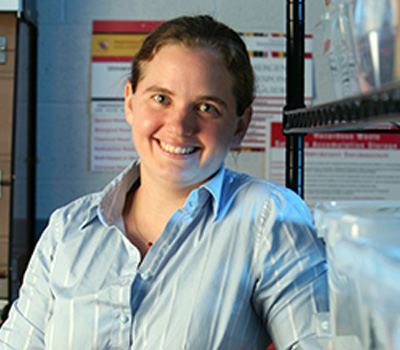How Dr. Sarah Bergbreiter's microrobotics work can transform medical interventions, disaster relief, and civil infrastructure monitoring
As ubiquitous as they may be, ants are one of the most amazing creatures on the planet. An individual ant is capable of carrying objects 50 times its own weight. Amazonian ants are able to sacrifice their own bodies as lifeboats for other ants to travel through floods, and fire ants can band together to form bridges to carry others across. It is no wonder then that ants, and other insects like them, are being used as models to design microrobots with similar properties and capabilities. Imagine if after a natural disaster devastated the lives of thousands and demolished structures, we were able to release buckets full of microrobotic "ants" that could survey the area quickly, find victims beneath the rubble, assess whether buildings were structurally sound enough for rescues, and all the while send feedback to search and rescue teams.
Dr. Sarah Bergbreiter of the University of Maryland imagines the applications of such microrobots each day in her lab where she uses her expertise in microfabrication along with inspiration from biology to create mobile microrobots and improve existing robot performance. Her research is focused on the challenges of engineering robotic systems down to sub-millimeter size scales. Applications for such research are widespread and have the potential to affect medical care, disaster relief, and civil infrastructure monitoring. In addition to working with small mobile robots, Dr. Bergbreiter and her team use microfabrication in support of larger robotic systems. The resulting research supports work in soft robotics to better interface with humans and small actuators to enable better manipulation and movement in larger robots.
Dr. Bergbreiter's current research includes:
-
New microfabrication techniques that incorporate both hard and soft materials to improve everything from locomotion in small-scale robots to the sense of touch for larger robots.
-
Studying how robots should locomote when they are millimeters in size. Everything from cockroach-size on up has been shown to run like a mass on a springy leg. Smaller robots don't have a lot of mass, but their feet do a good job of sticking to the ground implying that we need new models for how to move effectively and efficiently at small sizes.
-
Creating and fabricating complex 3-D structures using microfabricated components (that could include actuators, sensors, etc.). This will help build more complex robots as well as better sensors, optical systems, and medical devices at small scales.
-
Creating robust and efficient motors at small scales that have force and power densities greater than biological muscle.
-
Adding autonomy to robots at small scales so that they can work together to supply information, assemble structures, and collect data.
Dr. Bergbreiter's research at the intersection of robotics and microsystems has the potential for wide ranging applications. Imagine a world where surgery is a matter of swallowing a small robotic machine that operates internally and is minimally invasive, or robotic "spiders" that build webs to check for the structural stability of bridges and buildings. While these applications are in a more distant future, there are also many more near-term applications that can take advantage of this research. Small motors have potential applications beyond small-scale robotics including prosthetics and consumer electronics. Including soft materials in microfabrication processes for the first time can lead to improved sensor performance. In short, whether it is the small components that make up Dr. Bergbreiter's research or the large concepts they may become, her microscopic work is sure to influence our world in a big way.
Bio
Sarah Bergbreiter joined the University of Maryland, College Park in 2008 and is currently an Associate Professor of Mechanical Engineering, with a joint appointment in the Institute for Systems Research.
She received her B.S.E. degree in Electrical Engineering from Princeton University in 1999, and the M.S. and Ph.D. degrees from the University of California, Berkeley in 2004 and 2007 with a focus on microrobotics.
She received the DARPA Young Faculty Award in 2008, the NSF CAREER Award in 2011, and the Presidential Early Career Award for Scientists and Engineers (PECASE) in 2013 for her research on engineering robotic systems down to sub-millimeter size scales.
She received the Best Conference Paper Award at IEEE ICRA 2010 on her work incorporating new materials into microrobotics and the NTF Award at IEEE IROS 2011 for early demonstrations of jumping microrobots.
Website: http://mrl.umd.edu


